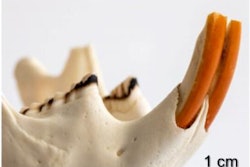Higher iron levels may be directly linked to more severe and widespread gum disease, even after adjusting for other possible risk factors, according to a large study recently published in the Journal of Periodontology.
Furthermore, ferritin, a key indicator of a person’s stores of iron, may mediate the relationship between systemic inflammation and periodontitis, suggesting that inflammation could explain this connection, the authors wrote.
“Elevated ferritin levels remained directly associated with periodontitis even after adjustment for confounding, indicating the possibility of a direct mechanism,” wrote the authors, led by Susilena Arouche Costa of Federal University of Maranhão in Brazil (J Periodontol, June 10, 2025).
The cross-sectional study analyzed data from 7,283 U.S. adults age 50 and younger using the Third National Health and Nutrition Examination Survey, which was conducted between 1988 and 1994. Periodontal exams were performed in two randomly selected quadrants, probing surfaces of all teeth except third molars. Clinical parameters, including clinical attachment loss (CAL), were measured at 28 sites, they wrote.
Blood samples were collected to determine ferritin levels, which were categorized into quintiles. Researchers used structural equation modeling to assess the relationship between high serum ferritin and periodontitis. The model accounted for both direct and indirect effects, considering factors like alcohol use, smoking, and insulin resistance.
High ferritin levels were directly linked to more severe periodontitis stages (standardized coefficient [SC]= 0.074, standard error [SE] = 0.033, p = 0.025) and mediated the relationship between low-grade systemic inflammation and periodontitis stages (SC = 0.012, SE = 0.005, p = 0.033).
Also, ferritin mediated the link between systemic inflammation and CAL ≥ 5 mm (SC = 0.010, SE = 0.004, p = 0.013), they wrote.
Additionally, ferritin acted as a mediator in the relationship between higher alcohol consumption (SC = 0.003, SE = 0.001, p = 0.044) and smoking (SC = 0.004, SE = 0.002, p = 0.016) with greater CAL severity. It was also associated with increased PD ≥ 4 mm through insulin resistance (SC = 0.006, SE = 0.002, p = 0.008).
The study had limitations. The timing of the observed associations between ferritin and periodontitis was unclear, so conclusions about causality could not be drawn, the authors added.
“The direct association observed between high ferritin levels and periodontitis, even adjusting for common risk factors, suggesting the excess of iron could contribute to the deterioration of periodontal tissues,” they wrote.




















